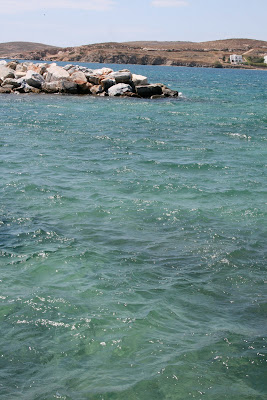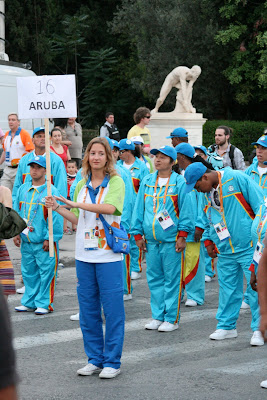Tuesday, June 28, 2011
Noikokyrio
Monday, June 27, 2011
Oh, Paros...
Sunday, June 26, 2011
Αντίο, Αθήνα!
- Against All Odds Project
Specifically, AAO is:
first, a ‘think-tank’: it promotes debate on occurring issues which need to be addressed within the framework of Architecture (in its wider understanding as spatial practice) regarding society, ecology and culture.
second, a ‘disseminator of ideas’: it raises public awareness on the value of Architecture (as spatial practice) in resolving significant current issues, as well as in offering a podium for the promotion of projects that address its main philosophy.
third, a ‘do-tank’: it sets targets for the fulfillment of which it creates partnership models with organizations, educational institutions and designers, becoming their strategic partner."
Okay, sorry to bore you, but I really liked the mission statement and explanation of their project. There's more, but you can read about it on their website (http://aaoproject.org/?page_id=1447).
This year, AAO's actions and events are under the title "Ethics/Aesthetics."
In the exhibition "twenty internationally celebrated architects, designers and artists from Europe, Asia and the US adopt various pioneering ways to devise new pratices for reinforcing social bonds and environmental protection, while transcending the established boundaries of architecture and the other spatial practices and redefining their role." It was broken into four sections:
- Activism, Groups with Vision
- Society & Aesthetics
- Identity, Professional Ethics
- Action - Reaction
A lot of these people should do TED talks.
A few of my favorites were "Worldbike," a more practical bike for use in third world countries, and various innovative and interesting ways to recycle.
At the end of the exhibit were "Slow Down Rooms." There were 8 "rooms" that "use mostly ephemeral materials to create inependent hybrid environments and to explore specific issues around the delineation of organic space and its potential reconstruction through the use of stereotypical materials, or unexpected cheap or discarded materials, and by means of alternative techniques with the emphasis on handicraft."
My favorite in the Slow Down Rooms was a "carpet" made entirely from spices:
- Contemporary Japanese Architecture
Reversible Destiny Lofts
(www.pinktentacle.com)
- ARRRGH! Monsters in Fashion
- Mobile in NY
Jewish Museums visited: 2
Friday, June 24, 2011
Shabbat Shalom!
Thursday, June 23, 2011
Exam Review
EXAM
PART 1: maps
1. map off attica
a. identify crucial places we've been
2. plan of acropolis
a. identify certain buildings
3. plan of agora
a. identify buildings
PART 2: PICTURES
· identify items as best and as completely as ou can in no more than 2 sentences
· **text books have good illustrations
PART 3: important people and other things
· mini paragraph or two
PART 4: essay
· intro, idea, examples to prove
Archaic Period: 625-480 BC
· Foundation of Democracy
· Persian sack of Athens
o physical remains of the city
**Classical Period: 479-323 BC** Golden age of Athens
· The Fifty Years
o between persian and pelop wars
o rise of democracy—radical democracy
o 2nd half: athenians start building up the akropolis
§ parthenon and propelya are truly periclean
· Pelopponnesian War
o other 2 akropolis buildings completed
o pelopponesians = spartans and their allies, including the
o sparta has infantry strength—warriors with big shields
o athens strength is naval
§ hide behind themistoclean wall (around athens, around pireaus)
· Fall of Athens
o spartans tear down walls
· Battle of Chaeroneia
o macedonians come from the north, defeat the city states
· Alexander the Great
320-30 BC Hellenistic
· Sack of Corinth
· Sula's sack of Athens
30-330AD Roman Empire
· Herulians sack Athens
330-650 AD Late Roman/Late Antique
· Constantine
ATHENS
· Accropolis: PPNE –built during second half of 5th century
o Propylia – pre pelop war
o Parthenon – pre pelop war
o Nike Temple –during pelop war: 420s
o Erichtheum – during pelop war: left unfinished at end
o Slopes of the Akropolis
§ Theater of Dionysus – built in 5th and 4th centuries BC (Classical)
§ Odeion of Herodis Atticus (2nd century, Roman)
§
· Agora
o Temple of Hephestas—best preserved temple (5th century)
o Tholos (circular)
§ base for 50 people presiding over the assembly
§ assembly = all Greek men
§ 17 had to stay
§ very democratic instutition
o Bouleterians
§ built new one and old one became archive room
§ 500 members of greek assembly
o Stoa of Attalos
o political, comercial and industrial center
Kerameikos
§ potter's corner
§ Themistoclean Wall
§ burials
o pots
Misc.
§ Pnyx
o assembly
§ Temple of Zeus
§ Roman Agora
o Tower of the Wind
§ Lysicrites monument
§ Hadrian's Library
§ Akropolis Museum
o Parthenon sculpture, etc.
§ triglyphs and metopes: Athenians against persian
· centaurs fighting against Greekst
· gods against giants
· athenians against amazons
· fall of troy
§ pediments
· west: contest of athena and poseidon for right to the city
o set in athens (spring, foliage, etc.)
· east: birth of athena from head of zeus
o set on mt. olympus
o athena = dawn of a new era (sun coming up, moon going down)
· Ionic frieze
o Panathenaic procession
§ bringing Athena her new dress on her birthday
§ lots of Athenians and horsemen
§ The Caryatids
§ Nike temple parapet
§ Archaic sculpture
· buildings, pediments, kouri—aristocratic monuments
PIRAEUS
§ shipsheds
§ walls
§ arsenal
§ museum
o bronze
o shield of Athena Parthenos
ATTICA
§ Battle of Marathon
o 10 years before fall of Athens (490 bc)
o Athens defeats attempted invasion by the Persians
§ Brauron
o Temple of Artemis—goddess of women, hunting, wild animals, responsible for children; virgin goddess, looks after young girls until they come of age. Bear danc
o Rooms for robe dedification to Ifiginay
§ Sounion
o Temple of Poseidon
o ship sheds
§ Eleusis
o Demeter
o temple of Demeter is designed for worship inside because it is designed for secret initiation rights
§ Eleutherai/Gyftokastro
o Forts: lunch, classical fortifications-not necessarily Athenian
§ Aigosthena
o swimming
DELPHI
§ navel of the ancient world
§ Apollo, oracle of Delphi
§ religious sanctuary
§ Panhelenic games
§ theater
§ Treasuriess
CORINTH
§ **location
o strategic location—controls isthmus: access between the peloponese and the rest of Greece
§ lots of disasters
§ Roman city, refounded by Julius Caesar
--
Athens is the greatest and most important of the Greek city-states
*historical and social reasons and explanations for that
why did classical Athens produce the wonderful things it did?
EVIDENCE
§ archaeology
o how to use archaeological evidence, how we know whats going on, come up with explanations
§ texts
o Palzanius (author)
§ tells use of buildings, etc.
o Thucydides
o Herodotus
THEORY
IMAGINATION
--
important Archaic people
§ Pisistratus
o tyrant—allows constitution to take place but makes sure it's always his men
o started temple of Zeus
o built temple of Demeter (agriculture) at Eleusis
o cult of Dionysus—dramatic festivals
o reorganized Panathenaic games
o uses cults to keep people and gods happy, public works (fountain houses), fosters pottery industry, brings in foreigners
§ Cleisthenes
o overthrows sons of Pisistratus, establishes foundation of Athenian democracy and divides city into 10 tribes that geographically unite the city: city, coast, plain
§ Themistocles
o battle of Salamos
o architect of naval strategy
o fortifies Pireaus
o builds Themistoclean wall
§ Persian sack of Athens
o wipes away archaic city, come back and they rebuild classical city
Classical period
§ The Fifty Years
o Parthenon, Propylia, city wall and long walls, Pireaus, Temple of Hephaistus, many buildings in Agora
o Perikles—democracy, builds long walls, Sounion, temple at Eleusis
§ Pelop Wars
o Nike Temple, Erichtheum, rebuild Theater of Dionysus
§ Fall of Athens
§ Battle of Chaeroneia—Philip 2 conquers Athens, Corinth and Thebes
o Philo
§ Piraeus arsenal
o Lycurgus
Hellenistic
§ Demetrius of Phaleron
§ Antiochus 4 (Syria...Olympieaeon)
§ Attalus, Eumenes (Pergamenes—near Turkey: Stoa of Attalos and Stoa of Eumenes)
§ Ptolemies (Cleopatra, Egypt)—tower of the winds
§ *Syria, Pergamon Egypt
Roman Empire
§ Herulian sack--trash agora, build more restrictive wall for inner city using trashed buildings
§ classical and roman athens has been wiped out
§ Caesar and Augustus (roman agora)
§ Nero
§ Hadrian (finished temple of zeus, arch, library)
§ Herodes Atticus (theater, stadium)
Lesson of the Day
Blogging is a great way to study.
The Count
No changes. For the first day ever.
Tomorrow
Exam. Taverna lunch. Farewell dinner with friends.

























